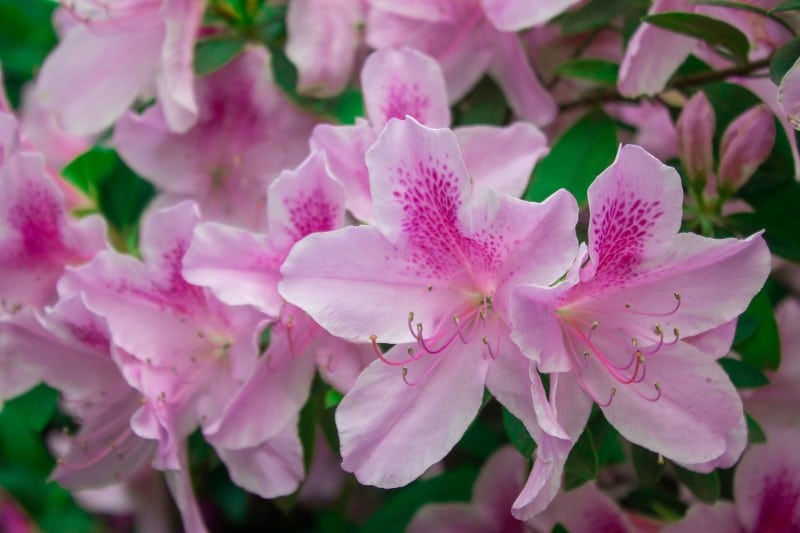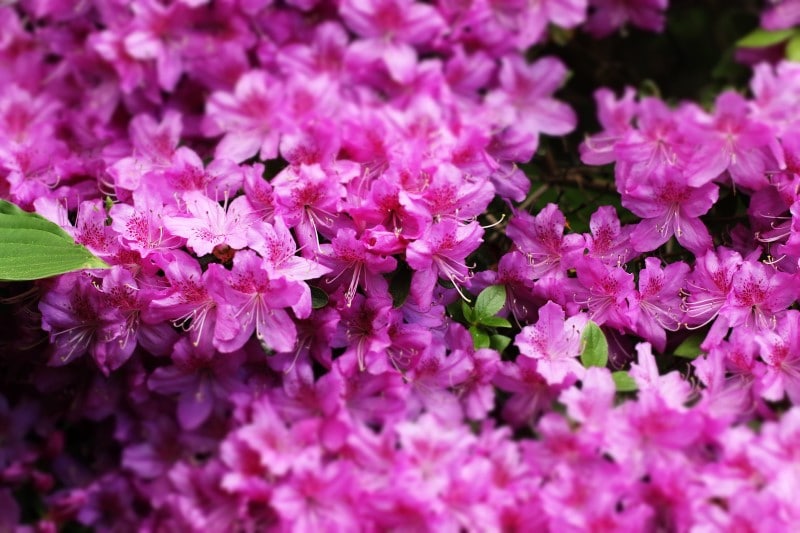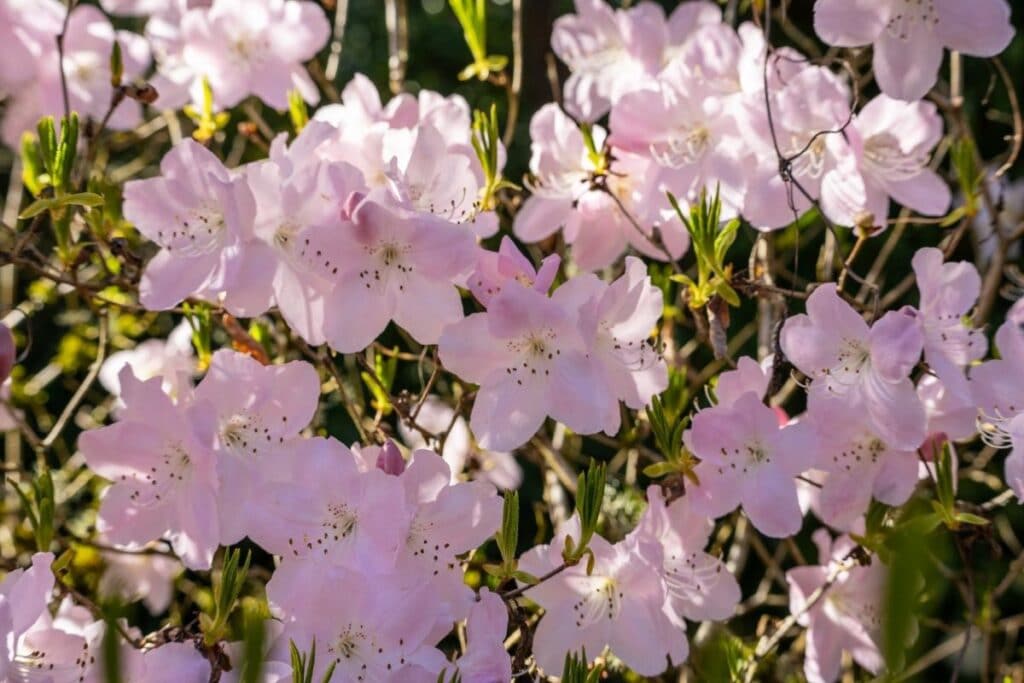If you like showy shrubs, azaleas should definitely be on your wishlist. These acid-loving plants come in a range of sizes and shapes, with deciduous and evergreen options to suit any gardener’s needs. Read on to learn how to grow and care for your own azalea plant.
What Is An Azalea Bush?
Azaleas are evergreen or deciduous broadleaf flowering plants from the Ericaceae family. These plants are very similar to the familiar rhododendrons and are in fact from the same genus. The usual distinction is simply that azaleas tend to be smaller plants with smaller leaves.
Size is very variable, however, and there are dwarf ground cover shrubs to tall plants of over 20 feet (6m) in this group! Azaleas originate from Asia, Europe, and North America. The American species are deciduous whereas the Asian species tend to be evergreens.
Leaf size varies from less than half an inch (12mm) to over 6 inches (15cm) in length depending on the type. Generally, they are oval-shaped and solid green, although some plants have variegated foliage. The deciduous types often have wonderful fall colors.
Azalea Flowers
Azalea flowers come in a variety of colors, but white, pink and red are the most common shades. Yellow and orange options are also available. Flower color varies a lot with these plants, however, even between different cultivars of the same species. Flower color can even vary on the same plant.
Flower size is also variable, and there are forms that produce flowers of less than an inch (25mm) in size, and others that produce 5-inch (12.5cm) blossoms. The flowers vary from single petaled forms to more complex arrangements like double and double hose-in-hose flower forms.
Most azaleas flower for a week or two in the spring, but there are a few summer flowering options and even the odd early fall bloomer. There are even cultivars that flower twice a year, in the spring and the fall.
Another distinction between azaleas and Rhododendrons is the number of stamens in the flowers. Azaleas tend to have 5 while the latter has 10.

Popular Azaleas Varieties
There is a great variety (thousands) of different azaleas available to gardeners. They can be either naturally occurring species or hybrids between more than one species. These beautiful plants come in all different shapes and sizes, to suit just about any application.
Some popular types of azaleas include:
Evergreens
The evergreen species originate in Japan. They have been hybridized and developed over time.
- Encore azaleas
- Kurume hybrids
- Southern Indica hybrids
- Satsuki hybrids
Deciduous
Some wonderful examples of deciduous Azaleas include American native species like:
- Florida flame azalea (R. austrinum)
- Piedmont azalea (R. canescens)
- Sweet azalea (R. arborescens)
- Flame azalea (R. calendulaceum)
- Coastal azalea (R. atlanticum)
- Pinxterbloom azalea (R. periclymenoides)
- Swamp azalea (R. viscosum)

How To Grow Azaleas Plants
These azaleas plants can be grown from seed but will not necessarily look the same as the parent plant since many of the azaleas you are likely to come across are hybrids. Cuttings will be a far more reliable way of propagating new plants with specific characteristics.
Take small softwood cuttings with a node and a heel and treat with a hormone powder. 1-2 inch (2.5-5cm) long cuttings taken while the plant is flowering, and treated with root hormone powder, can take root in 8-10 weeks. Misting will be beneficial and a greenhouse environment will help protect the small plants over winter.
These shrubs require rich, mildly acidic soil that drains well. They have a shallow root system and benefit from the addition of a 2-3 inch (5-7.5cm) deep layer of organic mulch. Lay the mulch down well outside of the plant’s dripline because their shallow roots can spread quite far. Make sure, however, to keep the plant’s crown clear of mulch to prevent rotting and disease.
Mulch will also reduce watering needs, and suppress unsightly weeds that will compete with your plant for nutrients and water. Nevertheless, be sure to water regularly in hot dry times and when plants are young or recently planted.
In very fast-draining sandy soils, more frequent irrigation will be necessary to keep these plants well hydrated. It is better to water the root zone and keep the foliage dry. Occasionally watering the foliage is recommended only in the morning so that the plants do not stay wet overnight
To get the most out of your azalea plant, take care to pick a good planting site. These plants grow best in dappled light positions like those found under trees. The ideal planting position would be under a tree with a deeper root system that will not compete with the shrub.
If you don’t have any suitable trees in your garden, your next best bet is to choose a site with morning sun, and afternoon shade. These plants will also benefit from shelter from harsh drying winds.
Azalea hardiness varies by species and cultivar but the hardiest deciduous forms can survive down to zone 3. The evergreens like it a little warmer and can be grown in zone 6 and up.
Care and Maintenance
You can plant azaleas at any time of the year, although plants will need some extra care while dealing with the heat after a spring or summer planting. Prune this plant as soon as the flowers start to die off. This will prevent removing the next season’s buds and encourage better flowering the following season.
While you’re busy, you can thin out any out-of-place, dead, or dying material. Azaleas are generally slow-growing plants, so it is best to prune when necessary, rather than to bring out the cutters every year.
If necessary, these plants can be renovated by cutting back hard to about a foot (0.3m) above ground level. It is best to do this in winter, with the understanding that the plant will not flower in the coming spring.
Fertilizing will not be necessary if you have rich organic soil. If your soil is naturally basic and you still wish to grow these wonderful plants, you will need to lower the pH. This is possible by applying Sulfur or Aluminium Sulfate. If you’re not sure of the pH of your soil, you will need to test initially and then again after amendments to know just where you stand.
In low nutrient soils, go ahead and apply a balanced slow-release fertilizer designed for acid-loving plants. Do this in the spring and early summer, and avoid fertilizing in late summer or fall because new growth may be damaged by cold.
These plants can be affected by pets such as lace bugs, caterpillars, bark scale, leaf miners, and spider mites. Root and crown rot can occur if the plant’s roots are kept wet, and other reported conditions include petal blight, gall, and leafspot diseases. Chlorosis, or leaf yellowing, is a common problem in alkaline soils.
Azalea Plants Uses
Horticultural Uses
Azaleas are a wonderful plant for bright, colorful spring and summer displays. Their preference for shady areas means they are ideal for brightening up gloomy parts of the garden that usually don’t hold much interest.
The smaller options are suitable for foundation plantings but they can make fine specimen plants and are even popular for bonsai. Plant types with different flowering times to ensure flowering throughout the warmer months of the year.
Wildlife Uses
Azaleas are great nectar plants for pollinators like hummingbirds, butterflies, and bees
FAQs
Conclusion
Azalea bushes are gorgeous and highly rewarding garden shrubs that really impress us with their color. These plants do have some special requirements when it comes to soil and planting site preferences but don’t be intimidated, chances are you can have great success with these prolific bloomers. Why not plant your own showy azaleas this year?
Up next:
- Azalea Flower Meaning and Symbolism
- Azalea Companion Plants
- Overwatered Azalea: How to Identify, Fix, and Prevent Water Damage
*image by melastmohican/depositphotos







